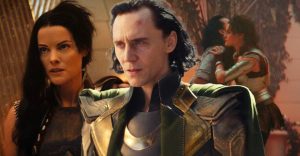10 Common Tropes In Almost Every Sonic Game

With the second Sonic the Hedgehog film set to release in spring 2022 and Sonic Frontiers, the first open-world game in the series, also coming this year, it’s an exciting time for a franchise that has already transformed in the 30 years since the character first appeared. However, some things have remained consistent throughout that time.
There are some clichés that have featured prominently in the franchise and continue to appear in the games to this day. Ranging from small quirks to more frustrating ones, these tropes have helped define one of the biggest franchises in video games.
Collecting The Magic Crystals

In the case of the Sonic games, the MacGuffin of choice is the Chaos Emeralds that are usually seen constantly switching possession between the heroes and bad guys. For objects that hold so much power, it seems that characters have a very hard time holding on to them for long. The Chaos Emeralds are an important part of the franchise though and not just the games. One thing we know about the movie Sonic the Hedgehog 2 is that the Master Emerald will be making an appearance.
Though the Chaos Emeralds are usually little more than a plot device, there is at least some satisfaction in using their power to turn into Super Sonic and become a lot stronger.
Boys Are Blue And Girls Are Pink

While Sonic is one of the most iconic characters in gaming and his blue and white design is a big part of this, the fact that his female counterpart, Amy, is pink does seem like some very old-fashioned color coding. It’s not the only example from the games either, with other lead female characters in the series like Rouge the Bat and Blaze the Cat being various shades of purple and pink.
The games also use very traditional color coding for characters in general, with edgy characters like Shadow having very dark designs, while Knuckles’ red design reflects his sometimes impulsive nature.
Too Many Quips

The Sonic games aren’t known for taking themselves too seriously, although some of the titles like Sonic the Hedgehog (2006) could be accused of that. Usually, though, the games keep a light-hearted tone and, whenever there is a real sense of tension being built, it’s usually cut by a moment of humor that almost always comes in the form of a Sonic quip.
While it does tie into Sonic’s character as a hedgehog that rarely takes things seriously and loves nothing more than going fast and looking cool doing so, there are some moments that might be better without an attempt at humor.
Favorite Food As A Personality Trait

No one would begrudge Sonic for loving food and eating one of his beloved chili dogs, but all too often his obsession with the snacks feels like it’s used in place of an actual character trait of substance. In the opening scene of Sonic and the Black Knight, for example, the wisecracking hedgehog seems more alarmed at the fate of his chili dog than the danger to his own life.
In instances like this, it makes it seem as though the games are more concerned with making Sonic seem cool and relatable than having him react normally to his sudden appearance in a battle with an extremely powerful enemy.
Damsel-In-Distress

Though its an even more common trope in almost every Super Mario game, the Sonic games also have a tendency to use female characters in need of saving as a plot device. Some of the female characters, especially those who are animals like Sonic, do have a decent amount of agency in the series, but unfortunately it isn’t always the case.
The use of the damsel-in-distress is especially prevailent in the 3D sonic games, with Princess Elise getting kidnapped at the start of Sonic the Hedgehog (2006) as well as Sonic and the Secret Rings and Sonic and the Black Knight both starting with women appealing to Sonic in need of help.
The Impenetrable Fortress That Is Easily Broken Into

For the amount that Dr. Eggman invests into building his fortresses, as well as his superweapons, robots, and all of the devices he makes use of in his evil schemes, it would make sense if the security was almost impossible to get past. Unfortunately for the villain, this is rarely the case. In games like Sonic Adventure 2, almost all the heroes manage to infiltrate his secret base.
Another trope in the games is Eggman unwittingly being the cause of his own downfall by inexplicably leaving trails of platforms and rails for sonic to run and glide on leading directly to his base. Sonic would likely have a much harder time if Eggman hadn’t left the perfect obstacle course for him.
Fighting The Same Boss Multiple Times

One of the more frustrating tropes in Sonic games, they do have the tendency to recycle boss fights albeit usually tweaked slightly to make it more difficult or interesting to play. It’s no surprise that the series likes to get the most use out of its iconic villains though, with Eggman and Metal Sonic just two of the best villains in the Sonic the Hedgehog franchise, according to Reddit.
Eggman is one of the best compromises in terms of this trope, though, because while he is reused multiple times for different boss fights, he almost always brings a new machine or environment with him. While it can be annoying, with enough small variations, this cliché can be a lot less noticeable.
The Villain (Almost) Always Gets Away

No matter how badly his evil plans are thwarted, or how serious those plans were, Dr. Eggman will reliably manage to get away and live to make even more trouble for the heroes of the series. The series relies on these villains, especially as they are some of the most entertaining characters, so they’ll usually be able to escape without too many consequences.
This seems especially odd in games like Sonic Adventure 2, in which Eggman’s plans involve destroying half the moon and threatening to give Earth the same treatment if they don’t comply with his demands. The series may like to portray him as a rapscallion whose plans always backfire on him, but these are some quite serious crimes to get away with.
Tedious Side Missions

It isn’t the only major video game franchise with this issue, as mundane sidequests are also a cliché that features heavily in The Legend of Zelda games, but the Sonic franchise has had some memorably frustrating ones. The Sonic series is responsible for the infamous fishing sections of Sonic Adventure DX with Big the Cat, so it’s fair to say this is a trope associated with the games.
Side missions can help break up a game and provide some more lighthearted gameplay as a change from the central campaign. When these missions are long, boring, and not very well thought-out, though, it is a trope that’s less easy to look past.
Questionable Physics

Some tropes are more fundamental than others to the Sonic series and it seems as though having a very loose approach to science is one of these. Even the gameplay the series is famous for, of Sonic racing through stages, has the fastest creature constantly come to an immediate standstill when hitting objects without the catastrophic impact that would usually be expected.
In a more obvious example of questionable physics, in games like Sonic Adventure 2, Sonic has traversed outside the Earth’s atmosphere without a spacesuit or any other protection for his body. Eggman successfully blowing the moon in half in the same game also seemed to cause fewer issues than a player would expect. In the end, the less realistic physics of Sonic games is more fun, so it’s hard to see it changing anytime soon.

















